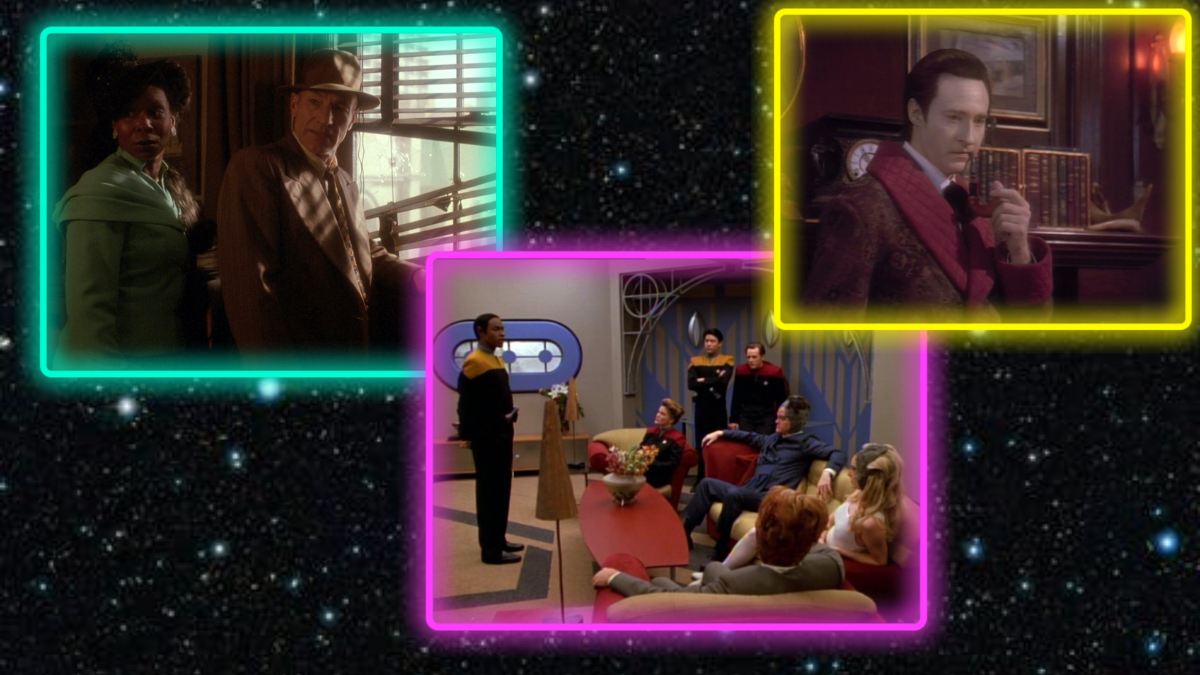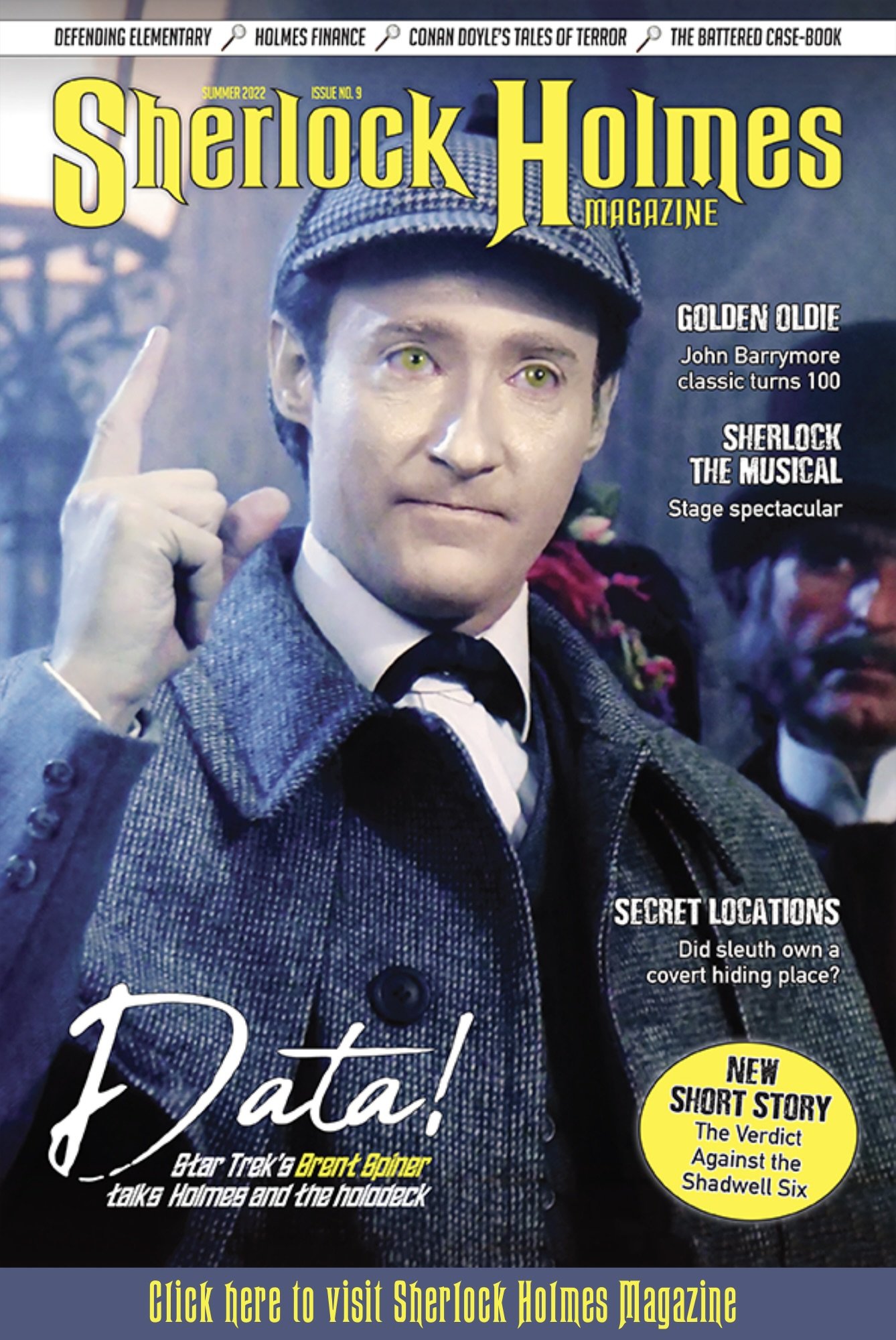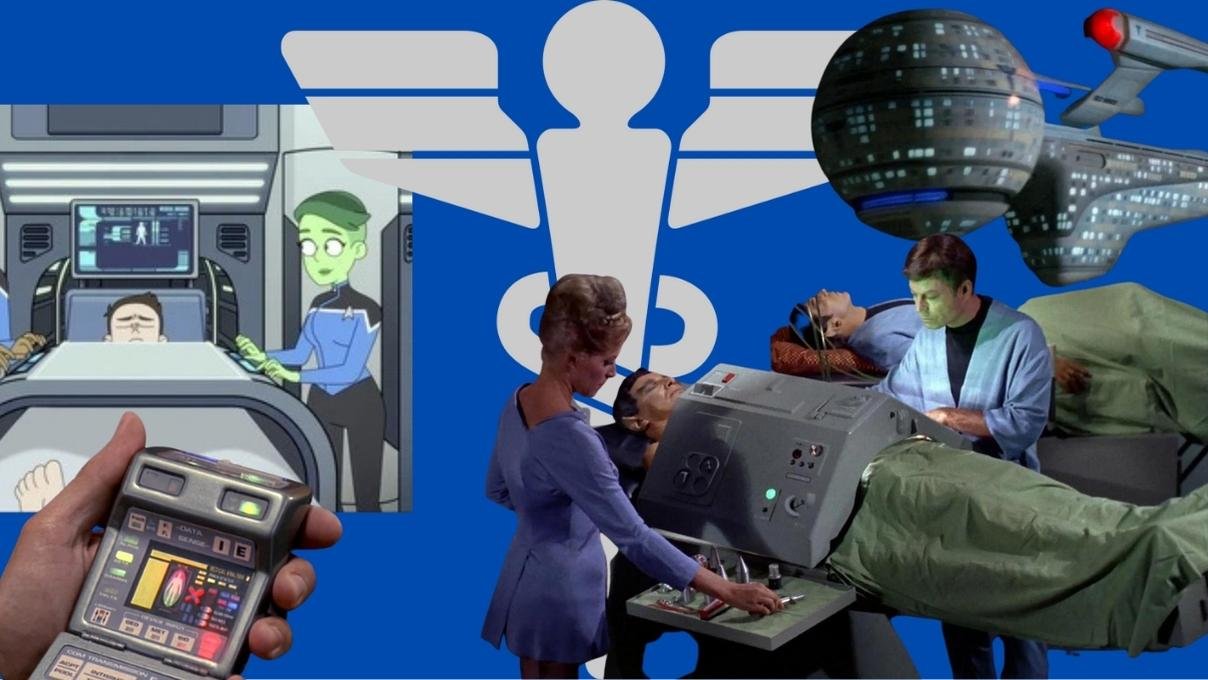T's Trek Trivia Tuesday: "I Love a Mystery"

From Dixon Hill to Sherlock Holmes to Lieutenant Tuvok, STAR TREK features various kind of detectives
It has been said that every story is a mystery story. True, not all of them involve crime or a culprit of some kind, but most stories would be pretty boring if we knew all the answers up front. Our curiosity compels us to read on, to discover the secrets an author is holding back; to live through the revelation of a character’s past or gasp when we find out that the lovers are long-lost siblings.
Star Trek is no different. Nearly every episode involves a mystery of some kind: Why is everyone suddenly so angry in The Original Series’ “Day of the Dove?” Are Geordi and Ro actually dead in Star Trek: The Next Generation’s “The Next Phase?” What are Tanis and Suspiria really up to in Star Trek: Voyager’s “Cold Fire?”
But Trek writers have crafted their own pure mystery stories, as well, starting with TOS’ “The Conscience of the King.” Sometimes the mysteries themselves are not quite up-to-par. (They are penned, after all, by science fiction writers, not Agatha Christie.) But many of them pay homage to other genres, such as Arthur Conan Doyle’s Sherlock Holmes stories or film noir. Let’s see if you can deduce the answers to some questions about the mysteries Star Trek has brought us.
Captain Kirk doesn’t like mysteries, claiming they give him a bellyache. By contrast, Captain Picard loves mysteries. in the TNG episode “Clues,” when Guinan questions his idea of fun, his enthusiastic response is: “It’s a mystery. Who was this man? Who killed him? Where’s the money he was talking about? It’s a mystery. Now we have to go search for clues.”
Picard, like many humans, finds a mystery irresistable. And his hero in the detective game is private eye Dixon Hill, star of page, screen, and holodeck. We first meet Hill in the first season episode “The Big Goodbye,” when things go awry, setting off a pattern of things-go-awry-on-the-holodeck episodes that make you wonder why they don’t rip that deathtrap out of the ship at their next stopover. But, like many characters, Dixon Hill had a different name on the page than he had when he hit the screen.
What was Dixon Hill’s original moniker and why did it get changed?
PIcard, having fun as Dixon Hill (Patrick Stewart), accompanied by Whalen (David Selburg), Beverly (Gates McFadden), and Data (Brent Spiner) in “The Big Goodbye”
When TNG show runner Maurice Hurley and actor Patrick Stewart discovered a mutual love of the mysteries of Raymond Chandler, they decided to create a character in the style of novels like The Big Sleep. Ultimately, their inspiration came from Humphrey Bogart’s character in the noir film In a Lonely Place. The character’s name? Dixon Steele, and that’s who Picard was written to play in the holodeck. So why change it?
At the time, a weekly crime drama had just ended its five-year run. It starred Pierce Brosnan as the titular character, Remington Steele. The producers feared, as producers do, that the Steele name would cause audience confusion, and the character’s name was changed to Dixon Hill.
Data finds Dixon Hill of interest, but his first and best love is Arthur Conan Doyle’s immortal detective, the man “Who never lived and so can never die" (Vincent Starrett, 221B,) Sherlock Holmes. accompanied by his best friend Geordi and the new Chief Medical Officer, Doctor Pulaski, he enters his own holodeck adventure as the deerstalkered sleuth.
The holodeck once again becomes a threat (surprise, surprise!) and Pulaski is taken prisoner by Holmes’ nemesis, Professor James Moriarty. Moriarty knows things about the computer that a holodeck character shouldn’t know, can draw a reasonable likeness of the Enterprise and can make the ship shake with a pull of a lever. It’s all very steampunk.
Moriarty clearly has powers beyond those of mortal holograms. But how did he attain them?
Geordi (LeVar Burton) and Data (Brent Spiner) as Sherlock Holmes and Doctor Watson face off against a holographic Professor Moriarty (Daniel Davis)
Let’s face it, we’re all prone to an occasional slip of the tongue. Accidentally calling your girlfriend by your ex-wife’s name, a spoonerism here or there. But more often than not the worst that happens is a little embarrassment or awkwardness. Usually the lives of your friends and crewmates don’t hang in the balance.
Geordi made a big boo-boo when he told the computer to create an adversary who was “capable of defeating Data,” an instruction that imbues Moriarty with something most holograms don’t possess: consciousness. But that’s not all. In order to truly vex our favorite android Holmes’ nemesis would also require access to the computer and the library files. A genius-level nineteenth century character with knowledge of twenty-fourth century technology. Very dangerous indeed.
Fortunately, Captain Picard is able to talk Moriarty down, promising to find a way to help him leave the holodeck someday. But that’s a different story altogether…
Constable Odo was already a security officer on Terok Nor before Starfleet liberated the Bajorans and renamed it Deep Space Nine. In DS9’s second season, he is forced by Starfleet to begin keeping a security log, immediately before being thrust into a noir-style adventure.
The episode “Necessary Evil” is a love letter to film noir, complete with a Philip Marlowe-esque first person narration, courtesy of Odo’s log, flashbacks to years earlier, suffused in a blue filter, a murder and an attempted murder, and lots of suspects.
When Quark is nearly murdered, Odo looks to the past to find a motive. Five years earlier, Gul Dukat approached Odo, asking him to solve the murder of a shop owner named Vaatrik. Odo’s reputation for integrity leads the Gul to believe him to be right for the job of PI.
In the grand tradition of films like The Maltese Falcon, a MacGuffin is at the center of the story: an object whose function is mainly to touch off the action of the story. In the Avengers movies, it’s the Tesseract; in Arthurian legend, the Holy Grail; in Raiders of the Lost Ark, the Ark of the Covenant.
What is the MacGuffin in “Necessary Evil?”
Odo (Rene Auberjonois) and Quark's (Armin Shimerman) relationship was antagonistic from the outset, as shown in "Necessary Evil"
All the fuss in this case, the shop owner’s murder and Quark’s brush with death five years later, is over a list containing eight Bajoran names. After some asking around, Odo learns that they are names of Bajorans who were collaborating with the Cardassians during the Occupation. Vaatrik’s widow was using it to blackmail the men, now rich from their illicit dealings. Quark eventually got his hands on the list, Mrs. V. found out, and she hired an assassin to kill him. Odo sets a trap and Quark manages to survive through the rest of the series.
But here’s the thing: Mrs. V. didn’t kill her husband. It turns out he was one of the collaborators, too, and was keeping her in the lap of luxury! So how did he meet his maker? Odo figures it out. Five years ago, Major Kira was sent by the Bajoran Resistance to retrieve the list. Vaatrik walked in on her and she had no choice but to kill him and escape. The revelation puts a wedge between the two old friends, but only briefly, and eventually they end up dating, so it can’t have been too unsettling for the security chief.
It was a dark and stormy night. Tom Paris, unaware that he’s being watched, is playing Seven Minutes In Heaven with an alien woman. The voyeur, whose POV we’re seeing through, suddenly becomes agitated and accosts the couple. After a struggle, Tom pulls out a dagger and stabs the man, killing him, and the vision shifts to an alien bed, upon which Paris lies. For the rest of his life, we are told, every fourteen hours Tom Paris will relive the murder from his victim’s point of view.
Ouch.
The victim in this case is (or was) the preeminent Banean engineering physicist, one Doctor Tolen Ren. The woman Paris was playing tonsil hockey with was Ren’s wife, Lidell. Tom admits he was attracted to the Banaen woman, but swears he’s not a murderer. Still, murder victim’s memories don’t lie, and the Banaens have the capability of examining a victim’s memories after death, at least according to Minister of Science Kray. (You might say, as far as science goes, Kray is the Top Banana on Banea. Then again, you might not.)
In this case, however, the memory did lie. How is that possible, and who is the real culprit?
Paris (Robert Duncan McNeill) and Lidell (Robin McKee) are caught unawares in a film noir-style flashback in "Ex Post Facto"
This episode touches off a couple of themes Star Trek: Voyager went back to time and again. The first is Tom Paris being accused of a crime he didn’t commit. The second is Lieutenant Tuvok as detective. He’s as happy as a pig in muck (or whatever the Vulcan equivalent might be) as he questions suspects and examines evidence. A piece of strong evidence, as far as he is concerned, is a text string which appears at the bottom of the memory fragment proving Tom’s guilt.
Tuvok must be a fan of Hercule Poirot, because he calls a meeting of all the suspects at the scene of the crime. One by one, he reveals the clues he’s found and pieces them together. One of the other big clues is that in the memory, Paris and Lidell are the same height, while in reality, he’s several centimeters taller than she is.
I’ll tell you who is her height, though: the doctor who performed the memory transplant on Voyager’s hapless helmsman. He had means and motive - actually, two motives. Not only was the specialist in Banean anatomy intent on doing a little field research using Lidell’s anatomy, but the pair were planning on using the false memory to smuggle Ren’s weapons research to the Numiri, enemies of the Banean people.
Do YOU love a mystery? Check out my interview with Brent Spiner, where we discuss his book, Fan Fiction, and film noir, then pick up a copy of the Summer, 2022 Sherlock Holmes Magazine to read the rest of the interview, where we discuss the Great Detective himself. And THEN hop on over to the history article where I discuss film noir actor Elisha Cook Jr.
T is the Managing Editor for Daily Star Trek News and a contributing writer for Sherlock Holmes Magazine and a Shakespeare nerd. He may have been the last professional Stage Manager to work with Leonard Nimoy, has worked Off-Broadway and regionally, and is the union Stage Manager for Legacy Theatre, where he is currently working with Julie Andrews. after which he’ll be working on Richard III at Elm Shakespeare Company.










